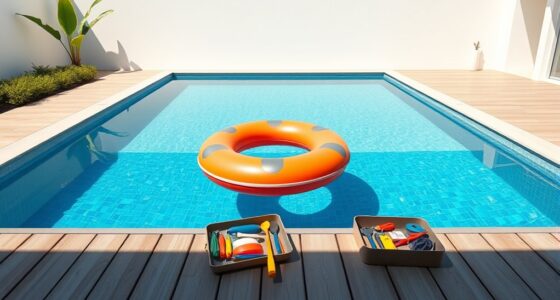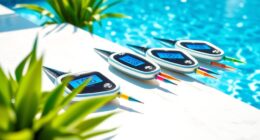To build speed and endurance in an endless pool, you can perform a variety of effective drills like sprint intervals, pace-break sets, resistance training, and technique-focused exercises. Focus on explosive starts, efficient pulls, and maintaining consistent pacing while gradually increasing volume. Incorporate resistance devices and long swims to boost strength and stamina. If you keep exploring, you’ll find detailed methods to maximize each workout and unleash your swim potential.
Key Takeaways
- Incorporate sprint intervals and pace-break sets to boost speed and simulate race conditions in the Endless Pool.
- Use resistance devices like paddles and drag socks to enhance power, strength, and efficiency during workouts.
- Practice explosive breakout starts and turn drills for improved acceleration and transition efficiency.
- Build endurance with long, steady swims and gradual volume increases to develop stamina and aerobic capacity.
- Include hypoxic training and breathing control exercises to increase lung capacity and respiratory strength.
Sprint Intervals for Explosive Speed

To boost your explosive speed, incorporate sprint intervals into your pool workouts. Start with a warm-up of easy swimming for 5-10 minutes to prepare your muscles. Then, sprint all-out for 20 to 30 seconds, pushing yourself to the maximum effort. Follow each sprint with a recovery swim at a slow, steady pace for 60 to 90 seconds to allow your muscles to recover. Repeat this cycle 8 to 10 times, aiming for quality over quantity. This high-intensity training boosts your anaerobic capacity, enhances muscle power, and trains your body to accelerate quickly. Consistently adding sprint intervals will help you develop explosive speed, making your overall swimming more powerful and efficient. Remember to listen to your body and gradually increase intensity as you improve.
Pacing Drills to Improve Consistency
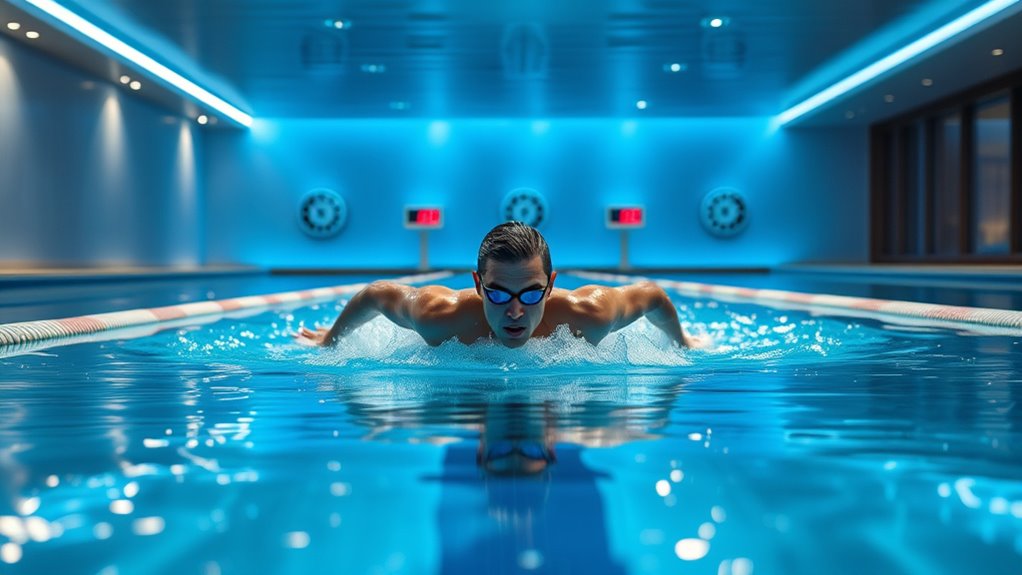
Maintaining a steady pace during your swim can substantially improve your overall consistency and efficiency in the water. Pacing drills help you develop a sense of rhythm, ensuring you don’t start too fast or slow down prematurely. To do this, set a target time for each lap and focus on hitting it consistently. Use a stopwatch or pool timer to monitor your splits, adjusting your effort as needed. Incorporate intervals where you swim at a set tempo, then rest briefly before repeating. Over time, this builds your ability to maintain a steady speed across longer distances. These drills sharpen your awareness of pacing, making your progressions smoother and your endurance more reliable during race conditions or extended workouts. Paying attention to your race pace can further enhance your ability to sustain a consistent speed over longer sessions.
Resistance Training With Adjustable Currents
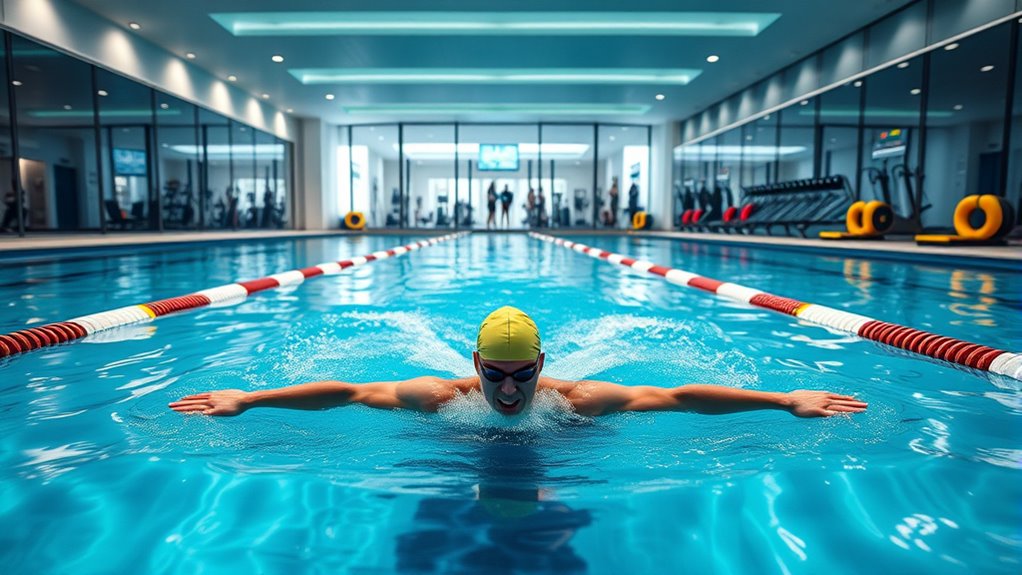
Have you ever considered how adjustable currents can elevate your swim training? By modifying the water’s resistance, you can challenge your muscles and improve strength without extra equipment. Increasing the current pushes you to work harder, engaging more muscle groups and building power. You can also decrease the resistance for recovery sessions or technique drills, allowing for controlled, low-impact movement. This versatility helps you target specific training goals, whether it’s building endurance or enhancing muscular endurance. Resistance training with adjustable currents also allows you to simulate open water conditions, preparing you for race scenarios. It’s an efficient way to add intensity to your workouts without changing locations or using bulky weights, making your training more focused and adaptable. The contrast ratio in your training environment can also influence your perception of water resistance, emphasizing the importance of optimal lighting and visual clarity.
Technique Focus: Catch and Pull Efficiency
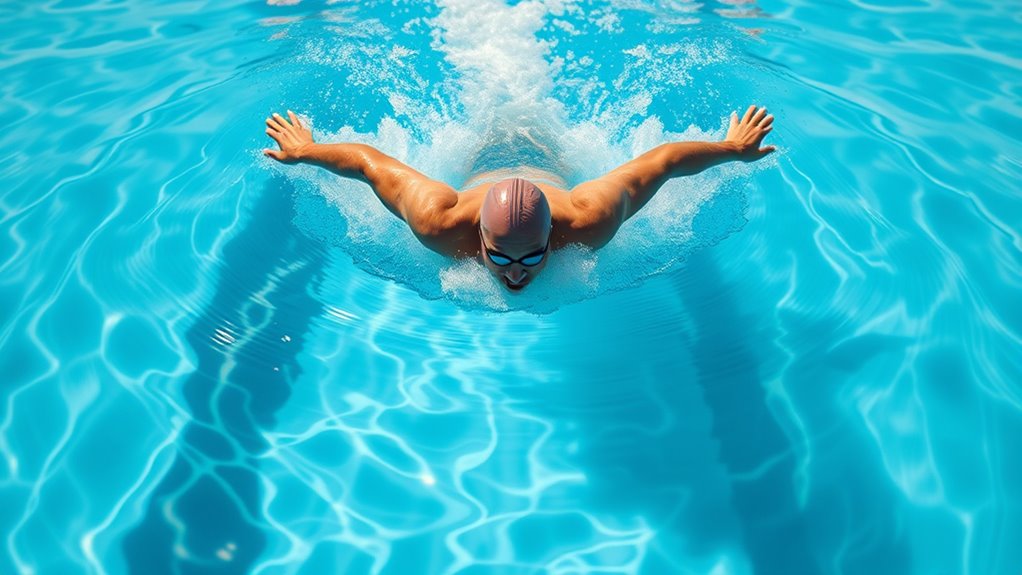
To improve your catch and pull, focus on streamlining your hand entry to reduce drag and maintain momentum. Keep your arm movements efficient by avoiding unnecessary movements and staying relaxed. Additionally, maintaining a proper body position helps maximize power and overall technique efficiency. Incorporating professional equipment and practicing with timing aids can further refine your technique and boost performance.
Streamline Hand Entry
A smooth and efficient hand entry is essential for maximizing your pull in an endless pool workout. As your hand enters the water, aim for a streamlined position, keeping your fingers together and your hand slightly angled downward. Avoid splashing or abrupt movements, which can disrupt your flow and create drag. Enter the water quietly, with your hand extending forward in line with your shoulder, maintaining a relaxed wrist. Focus on entering the water at the correct angle to set up an effective catch phase. A clean, controlled entry reduces resistance and allows you to immediately engage your pull mechanics. Consistently practicing this precise hand entry improves overall efficiency, helping you swim faster and conserve energy during your workout. Additionally, paying attention to your water entry technique can further enhance your stroke efficiency and endurance.
Optimize Arm Movement
Focusing on your arm movement during an endless pool workout can considerably boost your catch and pull efficiency. To improve, guarantee your hands enter the water smoothly, with fingers pointing downward. Engage your core to keep stability and prevent unnecessary energy loss. As you pull, keep your elbow high and focus on a strong, controlled motion. Avoid splashing or overreaching, which can slow you down. Instead, think of pulling yourself past the water with deliberate, powerful strokes. Maintaining a steady rhythm helps conserve energy and increases propulsion. Developing dynamic communication with your stroke technique ensures continuous improvement and better performance.
Focus on Body Position
Maintaining the correct body position is essential for maximizing your catch and pull efficiency in an endless pool workout. Keep your body aligned horizontally, with your hips slightly elevated and your head in a neutral position, looking straight ahead. A streamlined posture reduces drag and allows your arms to move smoothly through the water. Engage your core to stabilize your body and prevent unnecessary movement. Focus on keeping your body long and relaxed, which helps you extend your reach during the catch phase. Avoid excessive vertical movement or sinking hips, as these slow you down and waste energy. By uphold proper body position, you ensure that every stroke is more powerful and efficient, boosting your overall speed and endurance in the water.
Endurance Sets With Increased Volume
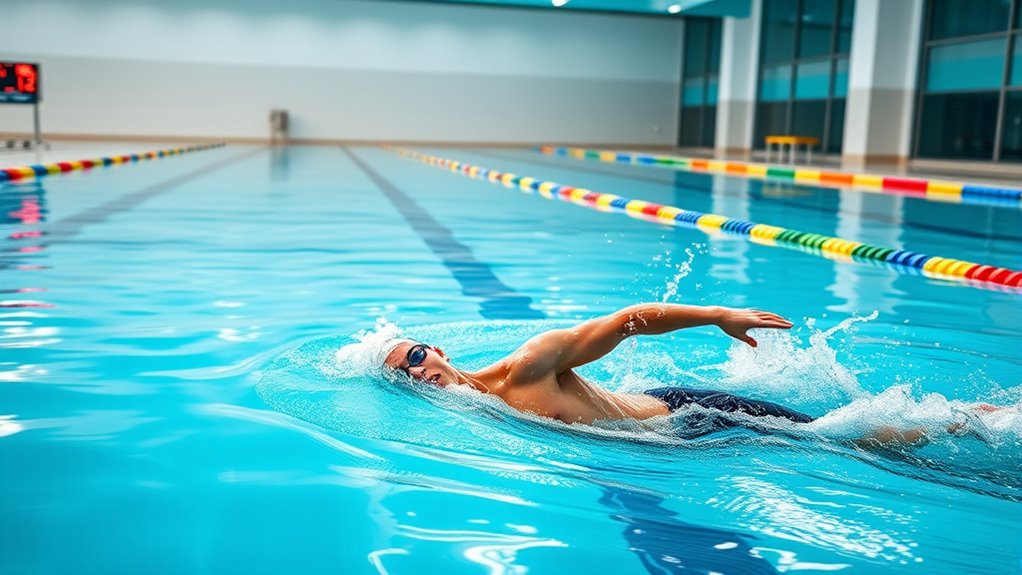
As you increase your workout volume, focus on gradually adding more sets or reps to build endurance without overloading your muscles. Keep your technique sharp to avoid developing bad habits or risking injury as fatigue sets in. Regularly check in with your body to prevent overtraining and make certain you’re maintaining proper form throughout each session. Incorporating grocery savings strategies can help you allocate resources to your training needs more effectively.
Gradual Volume Progression
To build endurance effectively, gradually increasing the volume of your endurance sets is essential. This means slowly adding more repetitions, extending your workout duration, or increasing the number of sets over time. By doing so, your body adapts without risking injury or burnout. Incorporating robust safety measures can help monitor your progress and prevent overexertion during these increases. Here are some tips to implement gradual volume progression:
- Increase workout duration by 10% each week
- Add an extra set once your current routine feels manageable
- Boost the number of repetitions per set gradually
- Listen to your body and avoid pushing through pain
This steady approach ensures consistent progress, boosts stamina, and reduces plateauing. Remember, patience is key—small, consistent increases lead to long-term endurance gains.
Maintain Proper Technique
When increasing the volume of your endurance sets, it’s crucial to prioritize proper technique to prevent injuries and maximize benefits. Focus on maintaining a streamlined body position, keeping your head aligned with your spine, and engaging your core throughout the workout. Avoid overextending your arms or rushing through strokes; instead, aim for smooth, controlled movements. Proper breathing is also essential—inhale and exhale rhythmically to sustain stamina and reduce fatigue. Pay attention to your hand entry and pull phase, ensuring they stay efficient and consistent. If you notice any discomfort or signs of fatigue, slow down and reassess your form. Maintaining proper technique not only helps you build endurance safely but also enhances your overall swimming efficiency. Regularly checking your ventilation considerations can help ensure optimal airflow and comfort during your training sessions.
Monitor Fatigue Levels
Monitoring your fatigue levels becomes increasingly important as you add more volume to your endurance sets. Staying aware helps prevent overtraining and maintains workout quality. Pay close attention to signs like declining form, persistent muscle soreness, or difficulty completing intervals. Use simple cues such as how your breathing feels or if your muscles feel unusually heavy. Incorporate regular check-ins during your session to assess your energy and focus. This helps you decide whether to push forward or take a brief rest. Additionally, recognizing physical signs of fatigue can help you better gauge your recovery needs and optimize performance.
- Track perceived effort using a scale of 1-10
- Observe changes in technique or breathing patterns
- Notice lingering muscle tightness or soreness
- Adjust volume or intensity if fatigue hampers performance
Breakout Starts and Turn Practice
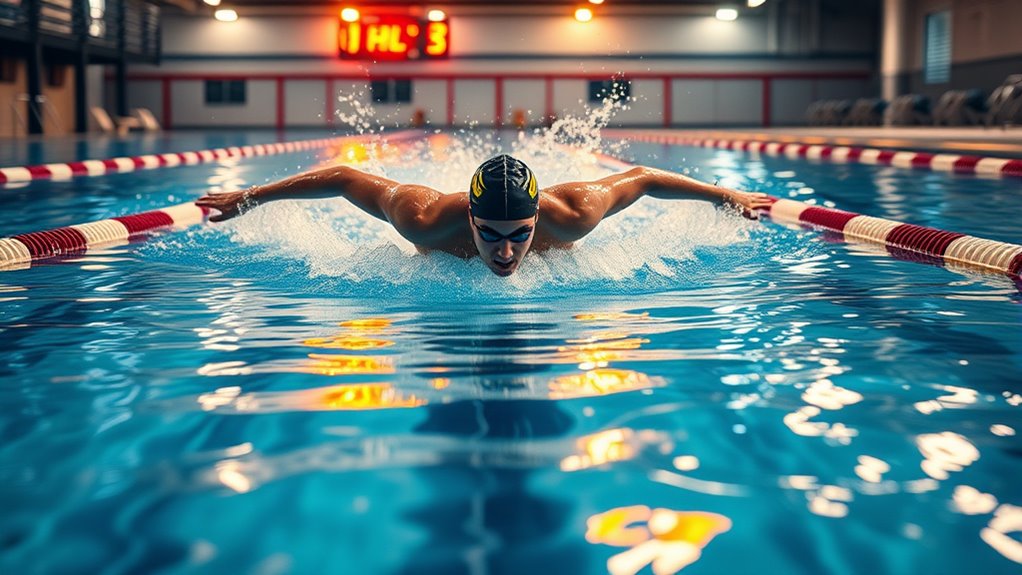
Mastering breakout starts and turns is essential for maximizing your performance in endless pool workouts. A strong start sets the tone for your entire swim, so focus on explosive pushes off the wall and quick, streamlined dives. Practice timing your breath and body position to reduce drag during the breakout. When it comes to turns, work on swift, efficient rotations that minimize time lost. Incorporate drills that emphasize push-off power and tight streamlines, then shift smoothly into your stroke. Repeating these drills builds muscle memory, so your starts and turns become automatic during races. Remember, the goal is to reduce hesitation and maintain momentum. Consistent practice in these areas will boost your overall speed and endurance, helping you swim more effectively and confidently. Additionally, paying attention to nutritional advantages can support your training recovery and performance.
Pace-Bresk Sets for Racing Readiness
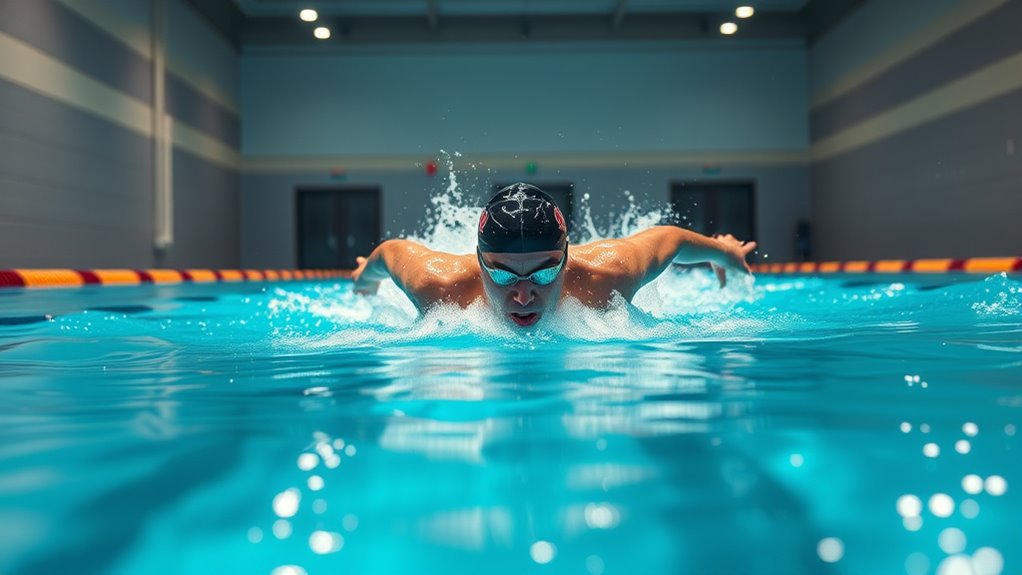
Pace-break sets help you simulate race conditions, so you can feel what it’s like to maintain tempo under pressure. They also allow you to fine-tune your pacing strategies, making you more confident during competition. Incorporating these workouts prepares you to perform at your best when it counts.
Simulate Race Conditions
To prepare effectively for race day, you need to simulate the intense conditions you’ll face during competition. This helps you build mental toughness and adapt to the pressure of racing. Use your pool to mimic race scenarios by adjusting pace, incorporating start and finish efforts, and practicing shifts. Push yourself to sustain race-pace efforts for extended periods, then recover as you would in a real race. Focus on maintaining proper form under fatigue and practicing pacing strategies. This not only prepares your body but also sharpens your mental focus.
- Incorporate intervals that mimic race start sprints
- Practice finishing strong with all-out efforts
- Simulate race transitions with quick pace changes
- Use pacing cues to stay consistent under pressure
Optimize Pacing Strategies
Building on your race simulation efforts, refining your pacing strategies guarantees you maintain ideal speed throughout your event. Pace-break sets are a powerful tool to achieve this. These involve alternating between faster and slower segments, helping you learn how to control your effort and avoid early burnout. To optimize, start with a target race pace and gradually increase the interval speed or duration over time. Use a consistent effort level during each segment, focusing on smooth progression and maintaining form. Record your splits to identify patterns and adjust accordingly. Incorporate these sets regularly into your training to build a sense of pacing and confidence. Over time, you’ll develop an intuitive sense of effort, ensuring you stay strong and steady when it counts most.
Hypoxic Training to Boost Lung Capacity
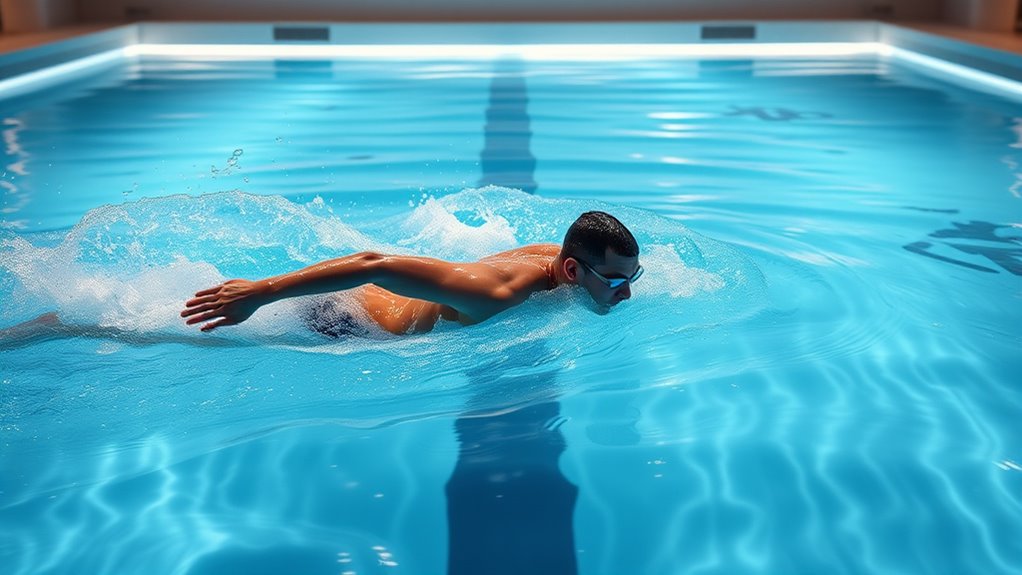
Have you ever wondered how to improve your lung capacity efficiently? Hypoxic training pushes your lungs to operate with less oxygen, forcing them to adapt and expand. This method involves practicing breath control and reducing oxygen intake during your endless pool workouts. By doing so, you strengthen your respiratory muscles and increase overall lung capacity over time.
Enhance lung capacity through hypoxic training by practicing breath control and reducing oxygen intake during workouts.
Key techniques include:
- Shortening breath holds during drills
- Incorporating deliberate hyperventilation periods
- Using mask training to simulate high-altitude conditions
- Gradually increasing hypoxic intervals for challenge
This training enhances your body’s ability to utilize oxygen more effectively, translating to improved endurance and faster recovery. Hypoxic training is a powerful way to boost lung function without added equipment or complex routines.
Mixed Stroke Intervals for Versatility
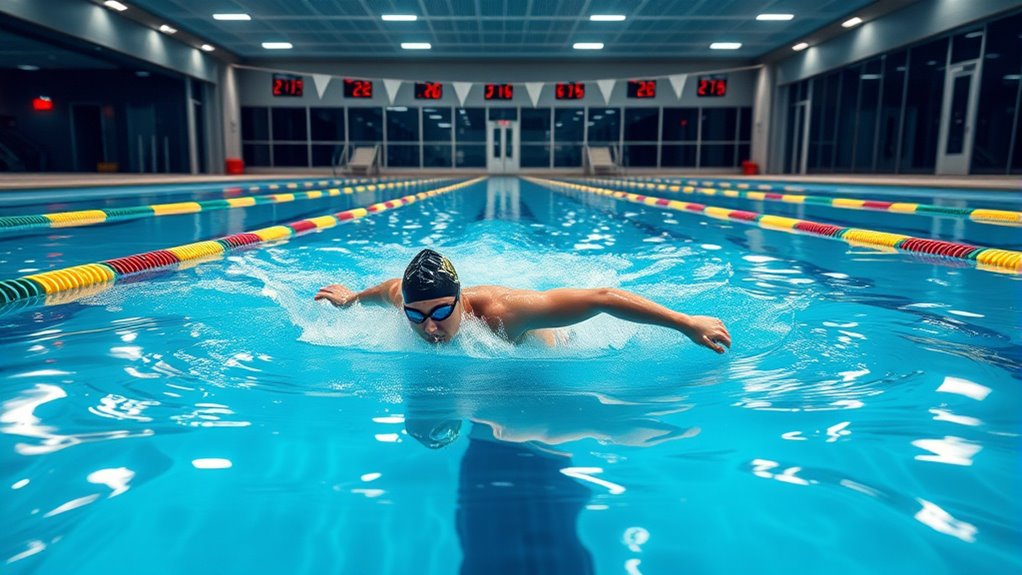
Incorporating mixed stroke intervals into your endless pool workouts can considerably enhance your versatility and overall swimming efficiency. Switching between strokes challenges different muscle groups and prevents fatigue, making you a more adaptable swimmer. For example, alternating between freestyle, backstroke, and breaststroke during intervals keeps your body engaged and improves coordination. To structure your workout, try the following:
| Stroke | Duration | Rest | Focus |
|---|---|---|---|
| Freestyle | 1 minute | 30 sec | Speed and breathing control |
| Backstroke | 1 minute | 30 sec | Posture and shoulder endurance |
| Breaststroke | 45 sec | 30 sec | Kick strength and glide efficiency |
| Choice Stroke | 1 minute | 30 sec | Overall versatility and recovery |
This varied approach builds endurance and makes you more adaptable across different swimming styles.
Speed Endurance With Short Rest Periods
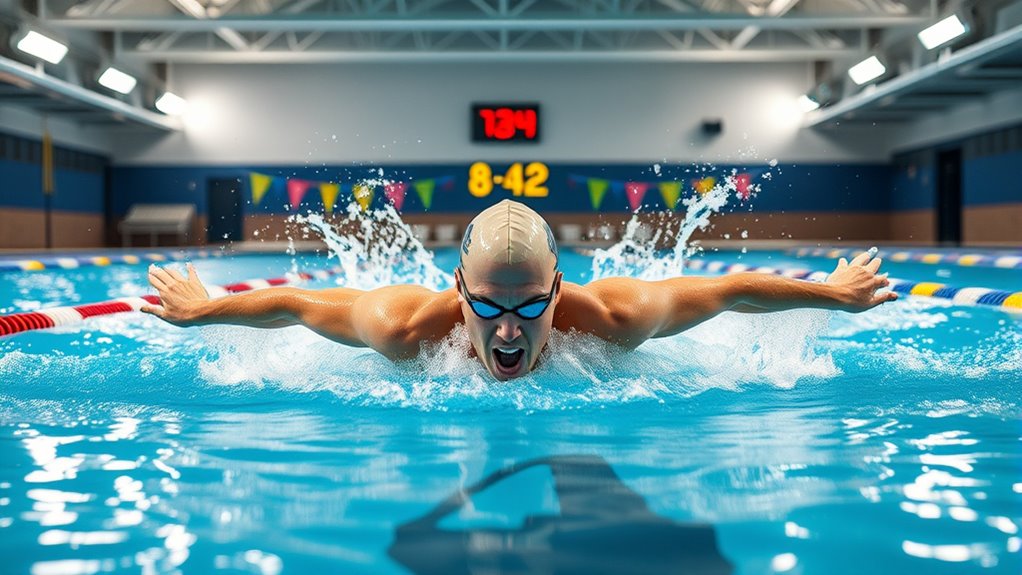
Speed endurance with short rest periods pushes your muscles to sustain high-intensity efforts, sharpening your ability to maintain fast speeds over longer distances. This training challenges your anaerobic capacity, forcing your body to recover quickly while staying in a state of high effort. It improves your ability to push through fatigue and enhances overall race pace. To maximize benefits, focus on these key elements:
- Keep rest periods brief, typically 10-20 seconds, to maintain intensity
- Alternate between sprint and recovery intervals to simulate race conditions
- Use consistent, fast-paced strokes to build rhythm and endurance
- Gradually increase the number of repetitions for progressive overload
This approach boosts your speed and stamina, preparing you for sustained performance in competitive settings.
Power Drills Using Resistance Devices
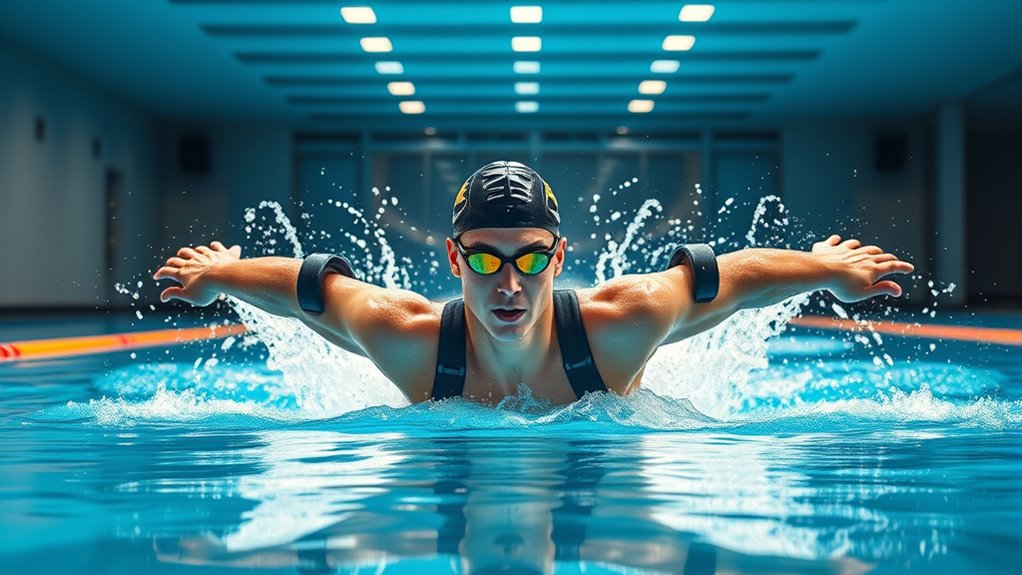
Using resistance devices in your pool workouts allows you to target specific muscle groups and increase overall power. Devices like resistance cords, paddles, and drag socks add extra load, forcing your muscles to work harder with each stroke. This increased effort boosts strength, helping you generate more force during each swim. Incorporate resistance drills into your routine by focusing on powerful pulls and kicks, emphasizing proper technique under resistance. These drills also enhance your ability to maintain speed against external forces, translating into improved performance in open water or competition. Remember to start with manageable resistance levels and gradually increase intensity to avoid fatigue or injury. Power drills using resistance devices are essential for building explosive strength and enhancing your overall swimming efficiency.
Long Continuous Swims for Base Building
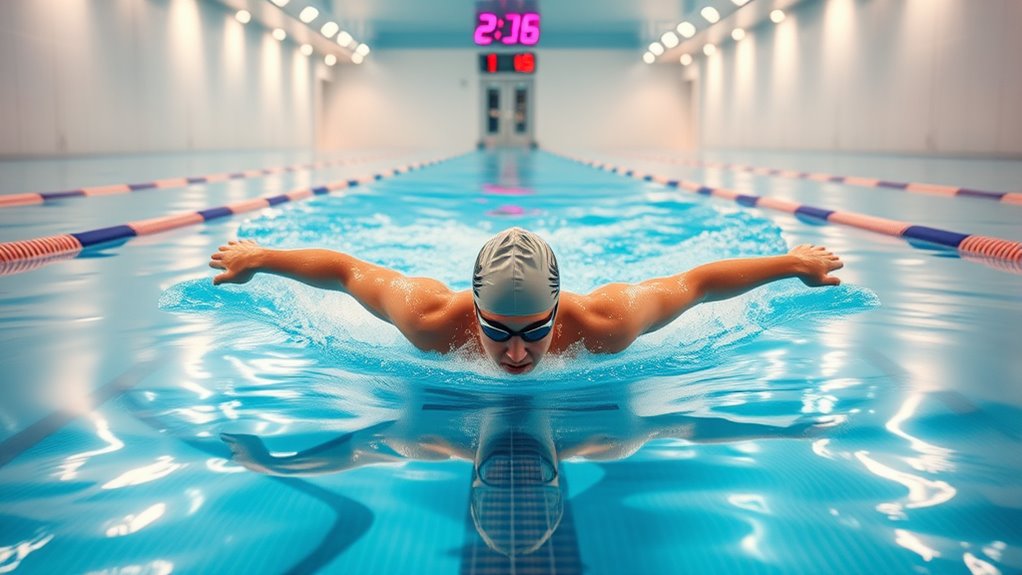
Building endurance in the pool requires committing to long, steady swims that gradually increase your time in the water. These sessions help your body adapt to sustained effort and improve overall stamina. Focus on maintaining a consistent pace, avoiding intense sprinting, and listening to your breathing. As you progress, extend your swim duration by a few minutes each week to build a solid aerobic base. Incorporate different strokes to challenge various muscles and prevent boredom. Remember, consistency is key to developing endurance.
- Keep your strokes smooth and efficient throughout the swim
- Use a pace clock or timer to track your progress
- Focus on breathing rhythm to sustain longer swims
- Gradually increase distance without sacrificing technique
Frequently Asked Questions
How Can I Tailor Workouts for My Specific Swimming Goals?
You can tailor your workouts by setting clear, specific goals like increasing speed, endurance, or technique. Focus on drills that target those areas, adjusting intensity and duration as needed. Incorporate interval training for speed, long swims for stamina, and technique drills to refine your form. Track your progress regularly, and modify your plan based on how your body responds and your evolving objectives to guarantee continuous improvement.
What Safety Precautions Should I Follow During Intense Pool Drills?
You should always warm up properly before intense drills to prevent injuries. Keep a close eye on your breathing and form to avoid overexertion, and don’t push yourself beyond your limits. Make sure the pool area is clear of obstacles, and never swim alone during strenuous workouts. Use safety equipment like goggles and caps, and listen to your body—stop if you feel dizzy or overly fatigued.
How Often Should I Incorporate Rest Days Into My Training?
You should incorporate rest days into your training every 1 to 2 weeks, depending on the intensity of your workouts. Listen to your body—if you feel fatigued, sore, or unmotivated, it’s a sign you need a break. Rest days help prevent injuries, promote recovery, and improve performance. Make sure to schedule at least one full rest day each week, especially after intense sessions, to stay healthy and avoid burnout.
Can These Workouts Help Improve Open Water Swimming Performance?
These workouts are like a secret weapon for your open water swimming. They can definitely improve your speed and endurance, helping you tackle challenging conditions more confidently. By focusing on drills that mimic open water scenarios, you’ll build the stamina and technique needed. Consistent practice in the pool translates well to open water, making you more prepared and comfortable when swimming in the wild.
What Equipment Is Essential for Maximizing Pool Workout Effectiveness?
You should prioritize a quality swim cap, goggles, and a kickboard to maximize your pool workout effectiveness. A pull buoy and resistance bands also help build strength and improve technique. Consider fins for added propulsion and a stopwatch or swim tracking device to monitor progress. Using this equipment keeps your drills focused, enhances your form, and boosts your speed and endurance, making your workouts more efficient and productive.
Conclusion
So, with these endless pool drills, you’ll be sprinting like lightning and building endurance faster than you can say “swim speed.” Who knew that practicing catch and pull or battling resistance could turn you into a water-bound superhero? Just remember, all that effort might just make your friends think you’ve got fins instead of arms. So go ahead—dive in, push your limits, and watch yourself become the swimmer you never knew you could be.




